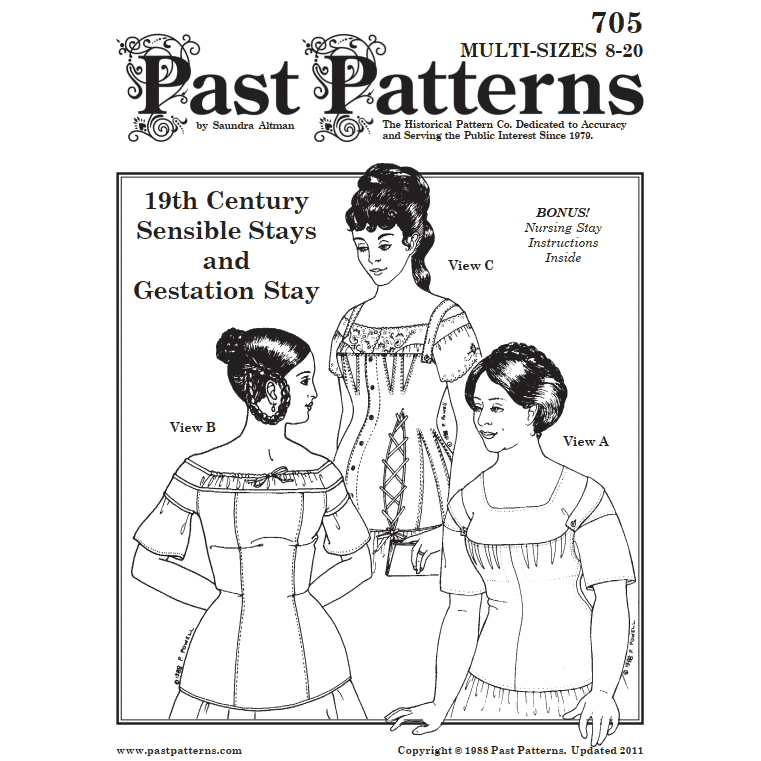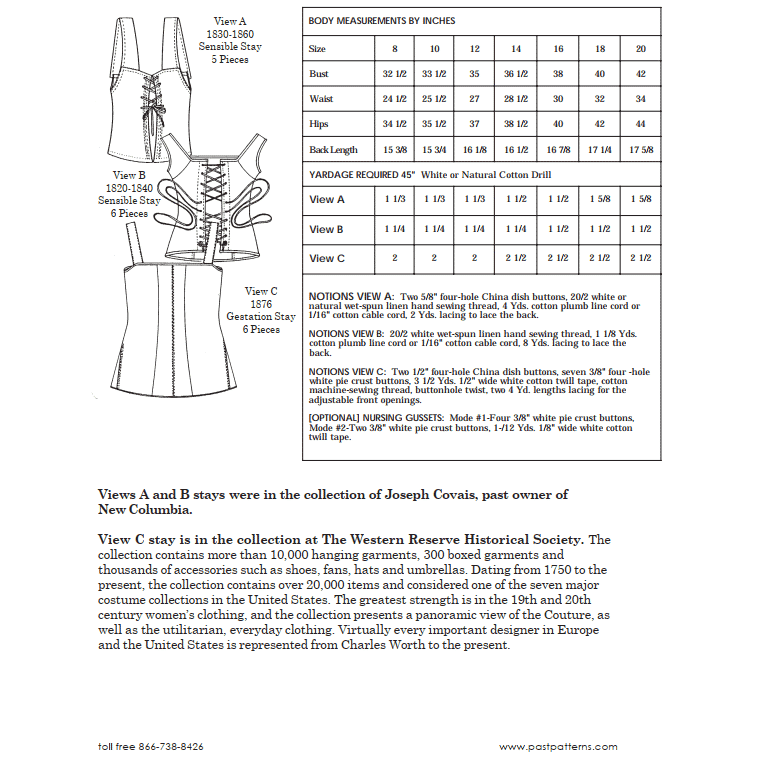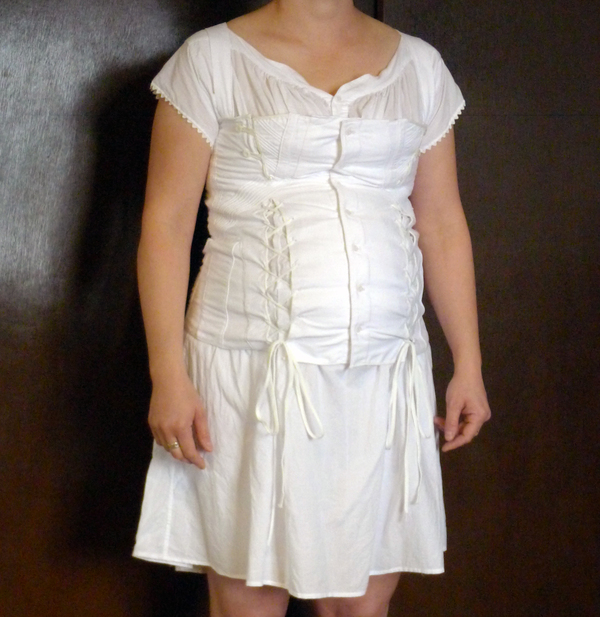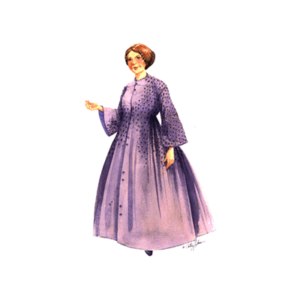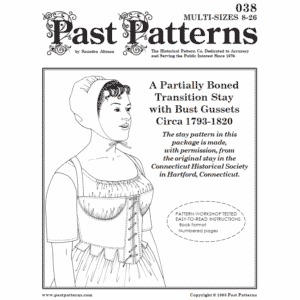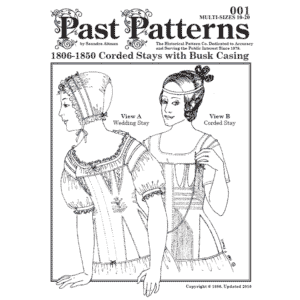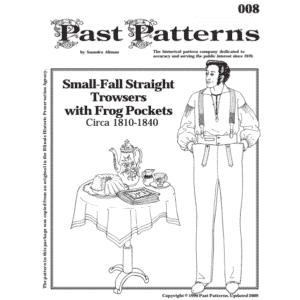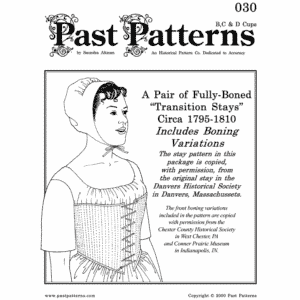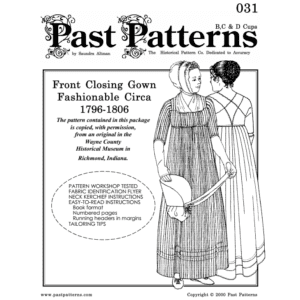19th Century Stays Sewing Pattern | Past Patterns 0705
$18.00
Comfortable and historically accurate, this 19th Century Stays Sewing Pattern by Past Patterns includes gestation and nursing variations. Multi-sized and suitable for intermediate sewists.
Get Free Shipping
On all US Orders over $50!
$18.00
Comfortable and historically accurate, this 19th Century Stays Sewing Pattern by Past Patterns includes gestation and nursing variations. Multi-sized and suitable for intermediate sewists.
Get Free Shipping
On all US Orders over $50!
All of our patterns tell a story.
Why Choose This Pattern?
19th Century Stays Sewing Pattern – Sensible Comfort with Period Accuracy
This 19th Century Stays Sewing Pattern is an original Past Patterns design, offering a versatile, supportive undergarment option adapted from early-to-mid 19th century originals. The design includes three historic variations: a traditional strap stay, a gestation stay for maternity wear, and a nursing stay adapted from an 1838 method. These comfortable, unboned stays provide shaping with minimal restriction—ideal for reenactors, museum interpreters, and living historians who prioritize both authenticity and ease of wear.
Historical Significance of 19th Century Stays
This pattern is modeled after extant stays dating from approximately 1820 to 1870, bridging the late Regency through early Victorian eras. Designed to push the bust upward and create a modestly defined waistline, these stays produce a silhouette typical of the 1830s–1850s, emphasizing lifted bustlines and gentle torso shaping. The gestation stay features abdominal lacing and shoulder straps that accommodate the changes of pregnancy. The nursing variation includes gussets adapted from The Workwoman’s Guide (1838), further supported by Demorest documentation from 1883.
Construction Details and Historical Techniques
The 19th Century Stays Sewing Pattern includes detailed, illustrated instructions for three views:
View A: Basic shoulder-strap stay with bust gussets
View B: Nursing stay with gusseted breast openings and authentic loop/button closures
View C: Gestation stay with pie-crust ceramic buttons and adjustable belly lacing
Hand-sewing instructions reflect period techniques, including even and uneven running stitches, overcasting, and fell stitching. Cording in the armhole and back seam allowances mimics historical shaping methods. Two gusset styles—triangular and curved—are provided for custom fit across bust and hips.
Fabric, Buttons & Authentic Notions
Recommended fabrics include:
White cotton drill
Cotton satin weave
Natural cotton calico
Authentic closures include reproduction ceramic “pie crust” buttons and plain china utility buttons. The original stay featured hand-bound buttonholes and hand-finishing on all gussets and shoulder straps.
What’s Included in the Pattern Packet
★ Multi-size pattern graded for Bust Sizes 32”–42”, Waist 24”–34”, Hips 34”–44”
★ Two large-format sheets (36"x45" and 36"x41") printed on 20 lb. white bond
★ 17 pages of detailed instructions with illustrated construction steps
★ Background history on 19th-century staymaking and maternity adaptations
★ Fabric layout charts and notes on stitching techniques from the period
★ Historic art cover with Past Patterns branding
Difficulty Rating: 3.5/5 – Intermediate
This pattern is recommended for intermediate sewists. The rating reflects the need to work with gussets, hand-sewn eyelets, optional nursing gussets, and detailed historical hand stitching. The gestation and nursing views add construction complexity but are well-supported by illustrations and historical notes.
Order & Shipping Information
This physical product is printed on sturdy paper and packaged in a reusable plastic sleeve. All Past Patterns designs ship with detailed documentation and are backed by decades of historical research. We combine shipping on multiple orders and offer both domestic and international service.
Explore the Matching Digital Format
Prefer to print at home or use a projector? A digital version of this pattern is available here:
👉 19th Century Stays Downloads
Copyright Past Patterns 1979–2025. All rights reserved.
Additional information
| Weight | 10 oz |
|---|---|
| Dimensions | 13 × 10 × 2 in |
This item is for single, non-commerical usage. If you want to mass produce items, please contact us.
Sizing Information
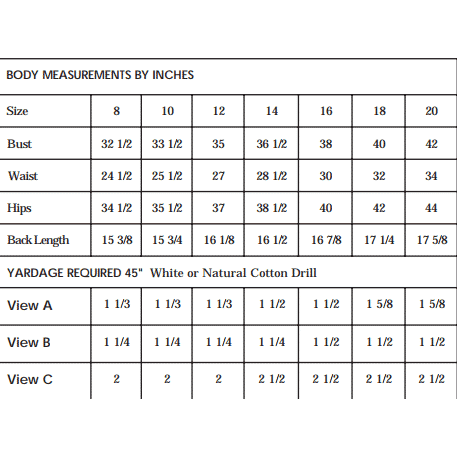
(Metric size sheet opens as a PDF in a new browser tab)
Preferred Vendors
Past Patterns works with vendors from all over the world to help us replicate the amazing articles of clothing. Now you can too!
Visit our preferred vendors page to order directly from some of our top recommended suppliers.
FAQ's
(Frequently asked questions)
Why are both Trowsers and Trousers listed on site?
Over the last 200 years, much like the human body, our style of language has changed. For vintage patterns, we attempt to use the language of the day where possible.
Can you grade (edit) a Vintage Revival pattern for my size?
please contact us with the specific pattern number and the specifications you require. We have staff available for this for an additional fee.
What sizes do Past Patterns patterns come in?
Our patterns, with some exceptions, are manufactured in sizes 8 through 26 for women and sizes 34 through 54 for men. Most patterns are multi-sized. For a complete listing of measurements in inches see the size chart.
Do you have vintage patterns (manufactured prior to 1950) that you want to sell?
we are always on the lookout for original, American designed, vintage patterns especially for categories outside of current items. We are interested if you have 1 pattern or 1000 patterns. Give us a call to discuss.
Why is my pattern size different from my off the rack dress size?
We use the U. S. Board of Standard Measurements to size our patterns. The ready made clothing manufacturers have their own set of sizes developed from their own statistics. For a complete listing of measurements in inches see the size chart.
How are the patterns packaged?
We package our patterns in two forms: Bond Paper and Tissue. Except for the Tissue patterns, each is slipped into a reusable plastic sleeve. Many contain documentation in the form of Historical Notes or the printer ie., Butterick. Because the patterns are printed in house to order, they can take from three to seven days. Tissue patterns, which are printed out of house, are available to ship immediately.
What does a Corset Kit contain in addition to the Corset pattern?
In addition to the pattern, the kits contain everything you need to make the corset except the thread. The kits contain, according to their type, fabric and lining, stays, clasp or busk board, back lacing, tape for finishing the edges, trim lace, ribbon, leather, tin stock, waist tape, punch and setter, eyelets, marking pencils, cording, reed and a loop turner.
Need a pattern in your language?
we can translate our instructions into just about any language
Have an old and incomplete Past Patterns item. What can I do?
The answer depends on if the pattern is still in production or not. If it is, please mail us the old pattern and we will ship you a copy of the latest pattern for a minimal fee along with normal shipping charges. If the item is no longer in production, we would need to know exactly what you have to determine the best course of action to help you.
What is the difference between a Past Patterns original pattern and a Vintage Revival pattern?
The Past Patterns originals were designed in house and based upon the research, disassembly and time of Saundra Ros Altman. These designs come from finds all over the United States reaching from San Diego, California to the Smithsonian Museum in Washington, DC. She created the initial patterns, the sizing charts and the instruction content. Many of the these patterns are multi-sized or are available in various sizes. For the most part, these designs are done taking into account the modern human body's shape, height and weight. The Vintage Revival patterns are traces or copies of an old, mass produced pattern; the first mass produced patterns came out in the 1850s. For the most part, you get exactly what came in the original package; in some cases, Saundra has appended historical notes to the instructions. The Vintage Revivals patterns, being copies of the originals, generally only come in one size and are based upon the size and shape of the human body from the era the pattern came from.
What software do you use to create patterns?
We utilize PW Studio for our designs. Isabelle Lott, a contributor over the years to Past Patterns, is the owner of the company and will be happy to answer an software related questions you have. Her software is available for licensing.
What measurements do I need to know to order a Corset Kit?
The bust and back length. The back length is measured from the prominent bone at the base of the neck to the natural waistline.
Where can I see the appropriate clothing fabrics for the 18th and 19th centuries?
You can see 1740 through 1940 fabrics in a book titled "Textile Designs" by Susan Meller and Joost Elffers. The subtitle states, "Two Hundred Years of European and American Patterns for Printed Fabric by Motif, Style, Color, Layout and Period and 1,823 Illustration in Color." What they don't say is that 90% of the swatches pictured are life size. The ISBN is 0-8109-3853-7. A second book is Wearable Prints, 1740-1860, History, Materials, and Mechanics by Susan W. Greene. The ISBN is 978-1-60635-124-6. Great books! Order it from your local library that has interlibrary loan capability if you cannot afford the price. There are now many sources for appropriate fabric through the Internet.
Where can I find antique patterns to purchase?
On the Internet try: "Patterns from the Past."
Need a pattern tomorrow?
we do offer expedited domestic shipping for extra fees. We can also expeditie international shipments but delivery dates overseas cannot be promised.
Becoming a Wholesalers of our patterns
We offer Wholesalers significant discounts that will allow both your and our businesses to flourish.
Why don't we sell PDFs of our patterns - First due to piracy. We have spent over 40 years creating and tracing these patterns along with researching them. We print and ship all of our patterns ourselves. If we started sending out PDFs, in no time, copies of our Intellectual Property would be all over the internet and we would be out of business. Second, some of our patterns are constantly being updated. We want our clients to get the BEST POSSIBLE version of our products.


